Renegade Carries Jeep to Wordly Crossover
By John Gilbert
Jeep, by itself, is the most-recognized name in automotives — all over the world. It is, of course, best-known in the U.S., but it also carved out a name and reputation in Europe and in Asia when it was created in 1941 to help the good guys win World War II.
Currently, the Jeep brand spans a wide range from rugged off-roading to luxury country clubbing, with the Wrangler climbing rocks and the Grand Cherokee carrying you and your guests to the fancy party. The latest addition to the Jeep line is the Renegade, and it adds a new dimension because it is so hopelessly cute that it is attractive, even though cute fairly shouts that it can’t be rugged. Then it proves it is more rugged than anyone could have guessed, as it hauls its cute little compact and boxy shape up rocky cliffs and over terrain that you’d never think of attempting in an ordinary lifespan.
As if to emphasize how popular Jeep is worldwide, the Renegade came into being with full encouragement from Fiat, which is handy, because Fiat owns Chrysler, which owns Jeep. How much Fiat backs the Renegade might best be explained by the fact that Fiat used an Italian plant to build the Renegade, with plans to sell it in Europe as well as in the U.S. and all around the world.
Fiat has returned to the U.S. with the cute subcompact 500, and it offers a hot-rod version of it with a high-tech “MultiAir” 4-cylinder engine bolstered by a turbocharger that turns it into a fun and dashing little pocket-rocket. At the same time, Chrysler, Dodge and Jeep have been using a modified version of a joint-venture 2.4-liter 4-cylinder originally designed by Hyundai when that South Korean company barged into the high-tech end of automotives five or six years ago.
When the Fiat MultiAir system was explained to me, it is a system that uses a series of oil-filled tubes connecting the intake and exhaust valvetrain. It would be a dual-overhead-camshaft system, except that there is only one cam; the other is replaced by the valves on one cam operating the valves on the other side directly, via the compressing of the oil tubes.
Instead of being complex, it is innovative enough to allow almost infinite overlap for expansive valve timing. Chrysler and Fiat engineers told me that the MultiAir system would work to improve any engine, so I continued to pester them to prove it by installing it on an engine other than the 1.4-liter Fiat. So they did.
All of which brings us back to the Renegade. You can choose from two engines in the lightest of Jeep off-roaders. First is the 1.4-liter MultiAir turbo engine — right out of the Fiat Abarth. It delivers 160 horsepower and 184 foot-pounds of torque, and comes with a 6-speed stick shift. The other engine is the 2.4-liter “Tigershark” 4-cylinder equipped with MultiAir2 technology on the valvetrain, and it is coordinated with a smooth-shifting 9-speed automatic, offering 160 horsepower and 184 foot-pounds of torque.
Just as the North Shore of Lake Superior was bristling to catch the first snowfall of the season, I got the chance to try out both a Latitude and Limited model, back-to-back. The look is identical — square shape, short overhang, amplified by exaggerated flares on wheel openings for large aluminum wheels and tires. The side glass extends low, copying the beltline from the Wrangler, which also lent some other design touches. From the rear, the design is exaggerated to make it look wider and more planted.
Renegades come in various models, starting with the Sport 4×2 at $19,995 including destination. The Latitude starts at $23,295; the Limited at $26,795; and the Trailhawk 4×4 at $25,995. While the Trailhawk is the built-for-trail off-roader, and comes only with 4-wheel drive, the other models are front-wheel drive with 4-wheel drive a $2,000 option.
The 4-wheel drive systems are the latest in Jeep’s ever-evolving concept to assure their vehicles will get up, over and through any terrain. Their Selec-Terrain system lets you twist a switch on the center dash to engage Auto, Snow, Sand, or Mud, and the Trailhawk version adds a Rock setting with a super-low crawl ratio. The auto setting keeps you in front-wheel drive until and unless the Renegade senses some traction issues, in which case you immediately go to 4×4.
When I attended the introduction for the Renegade, out in San Jose, Calif., I remember suggesting to Jeep brand manager Jim Morrison that I should probably drive the 2.4, and he stressed that I should really try the 1.4 first, because it not only is fun but remarkably peppy with the manual shifter.
He was right, and when I got both versions at home in Duluth I was impressed. Both had a firm and stable ride, attributable to 70 percent high-grade steel in the body, and an entirely new suspension, plus Koni shocks. The Latitude, with the 1.4 turbo and stick, was quick enough and held the road well, and had all the features you might want, including a giant, full-roof sunroof, with a removable front half that pops out in warmer times.
It handled very well on its all-season tires mounted onto 16-inch, 6.5-inch-wide aluminum wheels. Perhaps most impressive was the base price of $23,295 only escalated to $25,760 total with the sunroof and destination.
The Limited, meanwhile, had various luxury upgrades, including 18-inch, 7-inch-wide aluminum wheels with Goodyear Eagle Sport tires, and the 2.4 MultiAir2 engine with the 9-speed automatic. I must point out that the smaller 16-inch tires offered a bit more agility and possibly better traction, just by the difference in tread.
The fancier Limited interior included GPS navigation and a 6.5-inch display screen, remote start and keyless ignition. Its price, however, started at $23,295 and the sticker total was $25,760. Both Renegades were 4×4 and equipped well, with the silver Limited adding various classy touches. The Latitude was a traffic-stopping Solar Yellow color.
Curiously, the power difference between the two engines is small, and I found my fuel economy was between 22 and 24 miles per gallon with both vehicles.
Unlike the Cherokee, which is sized between the Renegade and the Grand Cherokee, and has narrow-slit headlights and a truly different look, the Renegade moves back toward the basis Wrangler appearance with a more square shape, as well as round headlights, and the trademark grille with its vertical slots.
Some very neat but subtle design touches indicate the Jeep designers had some fun with their work. There is an “X” on the bottom of the cupholders, for example, and a similar X designed into the taillights, in the shape of the side view of one of those “Jeri” gas cans, and the outline of the front end’s lights and grille are designed into the head and tail lights, and door panels.
Driving was an easy example of the 4×4 settings on auto, and the snow setting obviously would get use deeper into winter. There wasn’t a chance to do any serious off-roading, but back at the intro, I was convinced of the Renegade’s capabilities.
I had offered Jim Morrison a novel idea. When we went up on top of a mountain east of San Jose, instead of him riding with me, he could drive over the prepared off-road terrain, and I could interview him. It was unique, and several times he interrupted himself by scraping the undercarriage skid plate on some hefty boulders.
“This is a great new addition,” Morrison started. “Oops, we’re dropping down into a mud pit now, so I’ve shifted the ActiveDrive into Low, in the mud mode. Now we’ll walk it through some water…”
We descended into a major puddle, and water rolled up and over the hood. “We’ve got capabilities for fording about 20 inches of water,” Morrison added. “It has all extra seals, so whether you’re in a rainstorm or crazy water stuff. It’s really a lot of fun.”
As we heard heavy scraping underneath, Morrison shrugged and added: “I’ll put it into rock mode, now, so I can show you this crazy 24-degree breakover angle. It’s got 31 degrees of approach angle, so it looks like we’re going to hit this rock wall, but the Renegade will go almost straight up to get over it. And it’s got a 34-degree angle of departure.
“It’s surprising how smooth it is, but we build in those angles to all our Trailhawk models. Otherwise, we wouldn’t be able to go through what we just did. With the rock, mud, sand, snow, and auto settings, the auto lets the system do everything all by itself. We’ve got 8 inches of ground clearance, and our ActivDrive can keep us going even when we have only two wheels making contact. ActiveDrive will push all the power to the wheels where there’s grip.”
Climbing up on rocky terrain, you might find a situation where only one wheel is pulling. “When we’re going uphill, you can feel the torque being transferred around, moving power to the wheel that’s got traction, say the right front, then push it back to the rear,” Morrison explained.
It was a rugged little trail, and you wouldn’t drive on it in normal conditions. When winter gets into heavy snow, Morrison added, “it’s great to have Jeep capabilities.”
And if the snow isn’t deep enough to challenge the Renegade’s impressive capabilities, you can always settle for driving around in a vehicle that is incredibly cute.


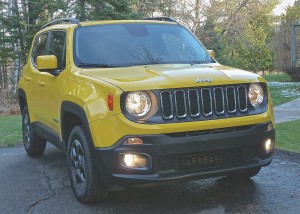
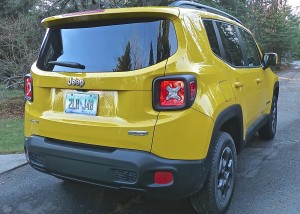
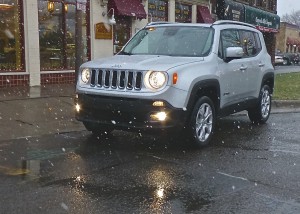
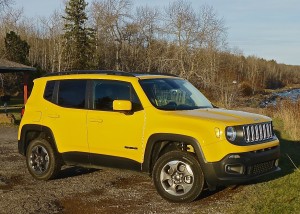
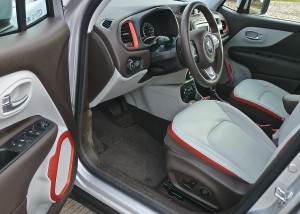
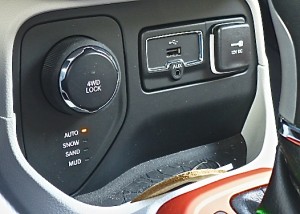
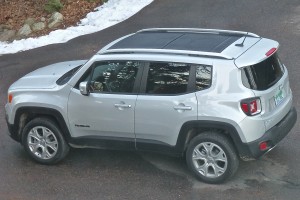
 John Gilbert is a lifetime Minnesotan and career journalist, specializing in cars and sports during and since spending 30 years at the Minneapolis Tribune, now the Star Tribune. More recently, he has continued translating the high-tech world of autos and sharing his passionate insights as a freelance writer/photographer/broadcaster. A member of the prestigious North American Car and Truck of the Year jury since 1993. John can be heard Monday-Friday from 9-11am on 610 KDAL(www.kdal610.com) on the "John Gilbert Show," and writes a column in the Duluth Reader.
John Gilbert is a lifetime Minnesotan and career journalist, specializing in cars and sports during and since spending 30 years at the Minneapolis Tribune, now the Star Tribune. More recently, he has continued translating the high-tech world of autos and sharing his passionate insights as a freelance writer/photographer/broadcaster. A member of the prestigious North American Car and Truck of the Year jury since 1993. John can be heard Monday-Friday from 9-11am on 610 KDAL(www.kdal610.com) on the "John Gilbert Show," and writes a column in the Duluth Reader.